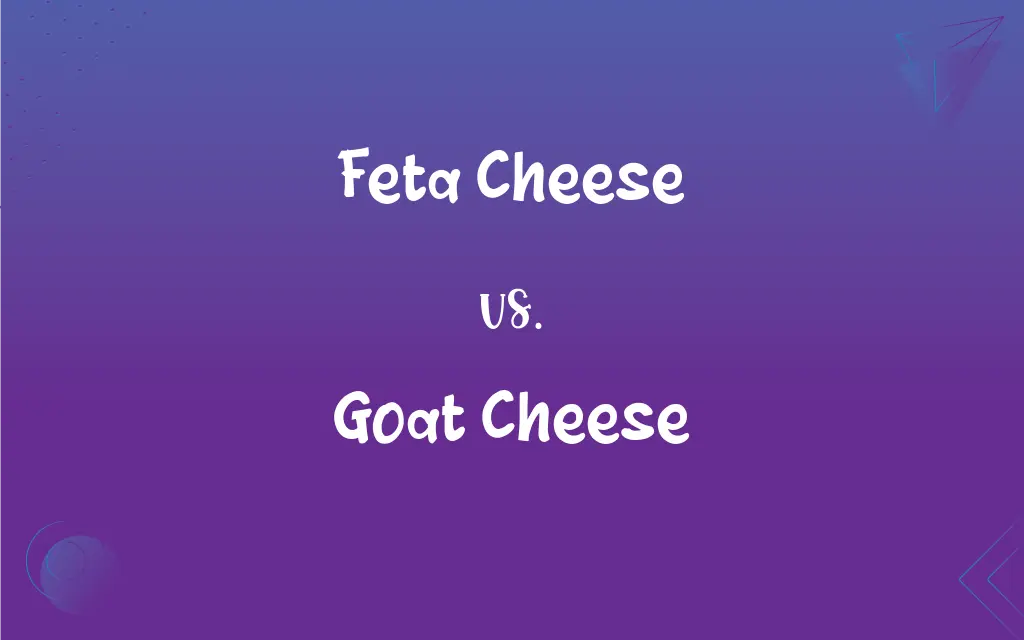Feta Cheese vs. Goat Cheese: What's the Difference?
Edited by Aimie Carlson || By Harlon Moss || Updated on July 4, 2024
Feta cheese, typically from sheep's milk, has a crumbly texture and a salty, tangy flavor, while goat cheese, from goat’s milk, often features a creamy texture and a milder, tangy flavor.

Key Differences
Feta cheese originates from Greece and is a brined curd cheese typically made from sheep's milk, although it can also contain goat's milk. In contrast, goat cheese, as the name suggests, is produced from goat's milk and comes in various forms and flavors, offering a creamy to crumbly texture. Both cheeses are appreciated worldwide, yet their textual and flavorful nuances distinguish them vividly on a gourmet plate.
Feta cheese is renowned for its crumbly texture and distinctive salty and tangy flavor profile, often utilized in salads, pastries, or served with olive oil. Goat cheese, enveloping a softer, often spreadable texture, presents a milder, slightly tart flavor and can be used in numerous dishes, such as pizzas, salads, and desserts, rendering it notably versatile in culinary applications.
Both feta cheese and goat cheese are rich in nutrients, offering a plethora of vitamins and minerals. However, their nutritional profiles differ slightly due to their milk sources. Feta cheese tends to have a higher sodium content due to its brining process, whereas goat cheese may offer a slightly higher fat content, providing a creamy, decadent mouthfeel.
In culinary applications, feta cheese and goat cheese often star in different roles. Feta, with its bold, pronounced flavor, often garnishes dishes where it can stand out, like in a Greek salad. Goat cheese, owing to its mild and creamy nature, often finds its way into dishes where a subtle, velvety texture and flavor are desired, such as in sauces or as a topping in appetizers.
Feta cheese generally pairs well with robust and bright flavors like olive oil, oregano, and robust vegetables like tomatoes and peppers. Conversely, goat cheese often complements lighter, fruity notes and can be paired with wines, fruits, and often used to balance the earthy flavors of dishes like beet salad or a mushroom tart.
ADVERTISEMENT
Comparison Chart
Milk Source
Primarily sheep’s milk, can be blended with up to 30% goat's milk
Exclusively made from goat’s milk
Texture
Crumbly and slightly grainy
Ranges from soft, creamy to semi-firm and crumbly
Flavor Profile
Tangy and salty
Mild, slightly tart, and sometimes earthy
Typical Culinary Use
Often used in salads, pies, and as table cheese
Used in various dishes, from salads to pizzas and desserts
Origin
Greece. Traditionally linked to Greek cuisine
Varied. Goat cheese is made and utilized worldwide in numerous cuisines
ADVERTISEMENT
Feta Cheese and Goat Cheese Definitions
Feta Cheese
Feta cheese often undergoes a curing process in a salty brine, contributing to its distinctive salty taste.
The feta cheese was soaked in a flavorful brine, enhancing its savory profile.
Goat Cheese
Goat cheese, while having a unique profile, is sometimes chosen as an alternative to cow's milk cheese.
They opted for goat cheese in the recipe due to its mild, distinctive taste.
Feta Cheese
Recognizable by its crumbly texture, feta cheese is often used to garnish various dishes.
She crumbled feta cheese over the pasta for an added zest.
Goat Cheese
Goat cheese is a dairy product made from the milk of goats.
Goat cheese can be soft and spreadable or aged and firm.
Feta Cheese
Feta cheese can be used in baking, often incorporated into pastries or pies due to its moisture-retaining properties.
The feta cheese within the spanakopita provided a delectably tangy bite.
Goat Cheese
Goat cheese is versatile in culinary use, from savory dishes to sweet desserts.
Goat cheese and honey on crackers make a delightful snack.
Feta Cheese
Feta cheese often pairs with Mediterranean flavors, such as olive oil, tomatoes, and oregano.
The feta cheese was marinated in olive oil and herbs, ready to be served with fresh bread.
Goat Cheese
Often featuring a tangy flavor, goat cheese is enjoyed in various culinary contexts.
She spread goat cheese on her bagel for a zesty breakfast.
Feta Cheese
Feta cheese is a brined, white cheese primarily made from sheep's milk, originating from Greece.
Feta cheese adds a bold, tangy flavor to Greek salads.
Goat Cheese
Goat cheese can be presented in various forms, such as soft, semi-hard, and hard.
The salad was topped with crumbled soft goat cheese.
FAQs
How is goat cheese made?
Goat cheese is made using goat's milk, often through a process of curdling, draining, and aging.
What is feta cheese made from?
Feta cheese is primarily made from sheep's milk.
What is the texture of feta cheese?
Feta cheese usually has a crumbly texture.
Can I use feta cheese and goat cheese interchangeably in recipes?
They can be used interchangeably in some recipes, but flavor and texture differences may alter the dish.
Is goat cheese suitable for lactose-intolerant people?
Goat cheese has lower lactose compared to cow's milk cheese but still may affect lactose-intolerant individuals.
Does goat cheese have a rind?
Some varieties of goat cheese have an edible rind, while others do not.
Is goat cheese good for baking?
Yes, goat cheese can be used in baking and pairs well with various ingredients.
Can goat cheese be melted?
Yes, goat cheese can be melted, though it retains creaminess rather than becoming stringy.
What is the flavor profile of goat cheese?
Goat cheese often has a mild, tangy, and sometimes earthy flavor.
What are popular dishes using goat cheese?
Goat cheese is popular in salads, pastas, pizzas, and even in some desserts.
What is the best way to crumble feta cheese?
Feta cheese can easily be crumbled with fingers or a fork due to its texture.
Can feta cheese be used on pizza?
Absolutely, feta cheese can be used as a topping on pizza, providing a tangy flavor.
Is feta cheese lower in fat than other cheeses?
Feta cheese generally has a lower fat content compared to some other cheeses.
Is all feta cheese made in Greece?
Authentic feta cheese is made in Greece, but similar cheeses are produced elsewhere.
Can goat cheese be used in salad dressing?
Yes, goat cheese can be blended into a creamy salad dressing.
How long does feta cheese last after opening?
Feta cheese, if stored properly, can last up to 3 months in the refrigerator after opening.
Which is saltier, feta cheese, or goat cheese?
Feta cheese tends to be saltier due to its brining process.
Is feta cheese aged?
Yes, feta cheese is typically aged in brine for several months.
How should feta cheese be stored?
Feta cheese should be stored in a brine or a milk bath in the refrigerator.
How can I use goat cheese in desserts?
Goat cheese can be used in desserts like cheesecakes, tarts, or paired with fruits and honey.
About Author
Written by
Harlon MossHarlon is a seasoned quality moderator and accomplished content writer for Difference Wiki. An alumnus of the prestigious University of California, he earned his degree in Computer Science. Leveraging his academic background, Harlon brings a meticulous and informed perspective to his work, ensuring content accuracy and excellence.
Edited by
Aimie CarlsonAimie Carlson, holding a master's degree in English literature, is a fervent English language enthusiast. She lends her writing talents to Difference Wiki, a prominent website that specializes in comparisons, offering readers insightful analyses that both captivate and inform.































































